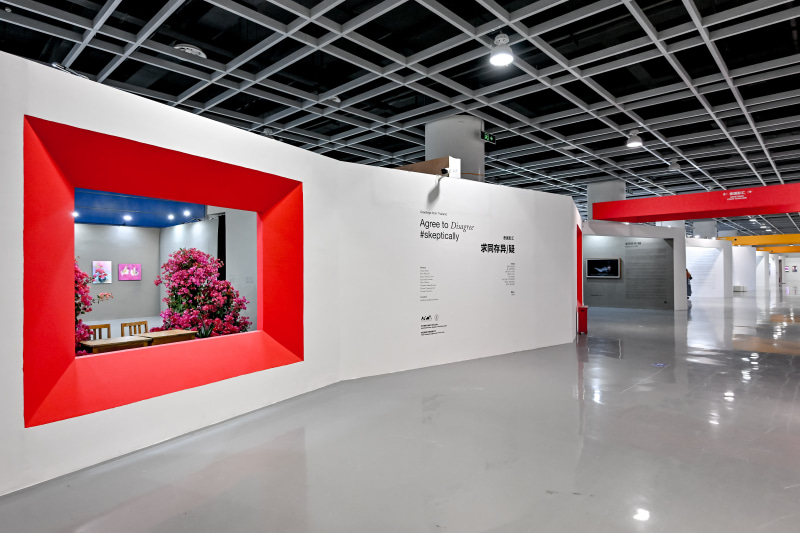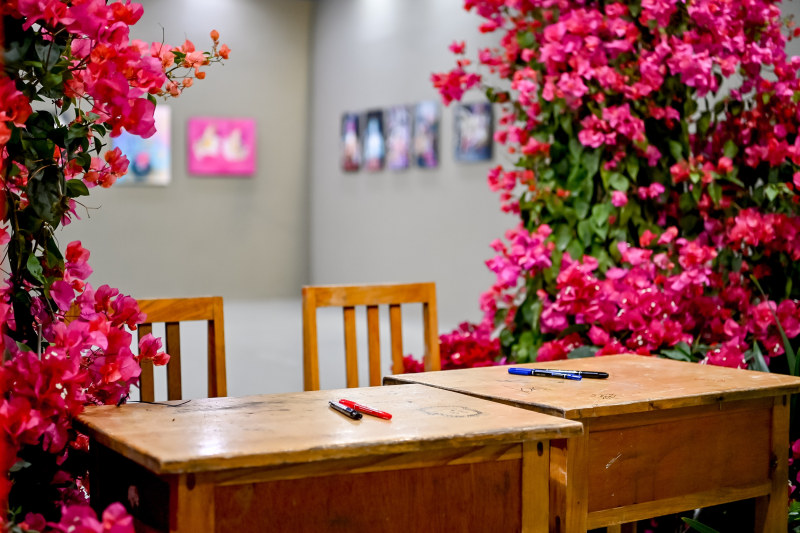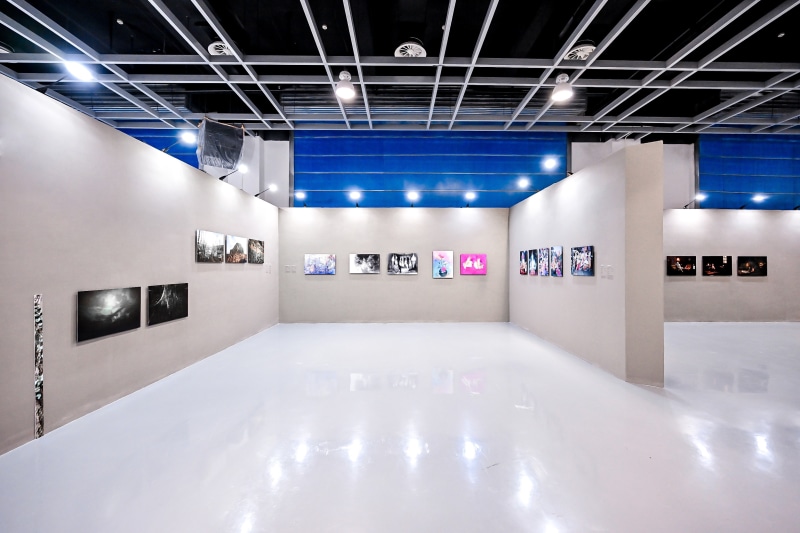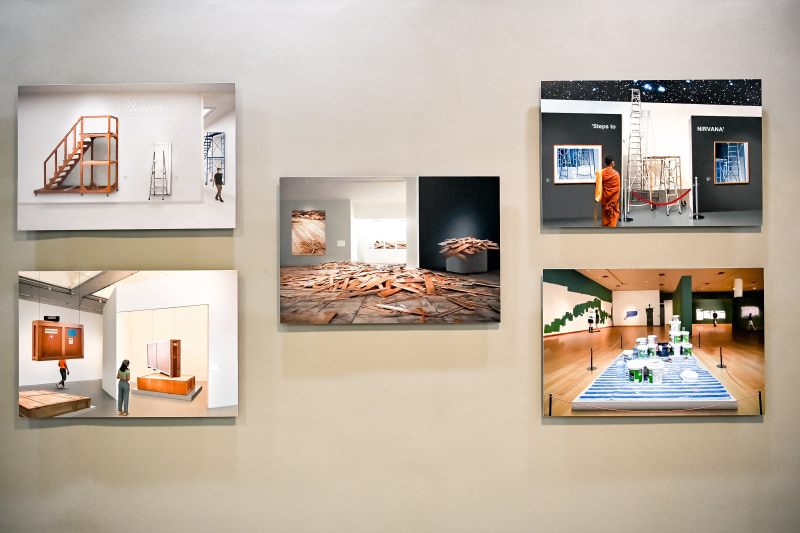Agree to Disagree #Skeptically
Thai Contemporary Art Exhibition
The new meaning of ‘Thainess’ which marks the new chapter of the nation began to take shape when Thai political geography changed completely (once again) by a group of non-parliament members that has risen to power in 2014. The two obvious major sides of political beliefs have become more visible, more challenging, and more heatedly discussed than the past decades. Cancel culture and call-out culture movements were introduced since then, dividing the citizen’s ideologies into various different aspects. To add the fire, controversial cases of Red Bull descendant’s hit and run and Italian Thai Development president hunting of a black panther have raised questions on Thailand’s justice system and left the nation speechless. The nationwide student movement raised attention to many issues that have been swept under the carpet: unimproved education, equality, uniforms, hair-cut, and harassment acts. These issues have never been stirred and publicly broadcasted through social media before. At the same time, university students also increase pressure on universities and lecturers to take action on what they see as the right acts. Within these few years, the Covid-19 pandemic lockdown experience served as a break, a period of isolation; and it has become an incubation of self-realisation for every single person. The aforementioned social and political phenomenon contributes to the growing attention towards political correctness for Thai people. In fact, youth generation has become the protagonist who now plays an essential role in this social revolution by questioning and reconstructing the notion of this new normalisation, both in society collectively and individually. All in all, these are the fundamental bases which affected the transition of Thainess both direct and indirectly.
Art, conceptualisation, and aesthetics are also criticized. Visual artists have to sought out new artistic identities; mirroring the reality through their own lenses. ‘Agree to Disagree #Skeptically Thai Contemporary Art Exhibition’ is a demonstration of Thai artists who present fresh interpretations of art, tradition and contemporary issues in the last 5 years. In regards to curatorial notion of Agree to Disagree #Skeptically, the exhibition focuses on three aspects, representing the change of ideology i. Scepticism, ii Taboo and iii. Equilibrium; which are apparently the works. Visual artists always imitate the world through their lenses and judgment. As contemporary creators, their function is to evoke a sense of curiosity, re-appraisal, and sensitivity regarding things and events that often oppose public consensus, common practice, norm, behaviour and tradition. To define the new attitudes of this artist group, we found that the method of approaching the questions in relation to society, norms, politics and aesthetics are different from the past; the concept of life, humanity, existence, and art, contributes to the revision of the world in this chaotic period. In fact, to prevent violence and harm, any kind of art is a perfect tool for peaceful communication and preventing lost. Artists should be able to take a firm stance and express their ideas, even though they might be against other people’s beliefs. Most of the works presented in this exhibition touch upon taboos, urging the audience to rethink about them in a different light. The people shall realise the truth through visual aesthetics by deconstructing the elements.
The creative works of all eight artists in this exhibition share three main points that link them to Thai contemporary art as they reflect and elucidate dimensions of well-known issues treated in three representative ways: i. Skepticism ii. Taboo and iii. Equilibrium.
i. Skepticism: Skepticism towards the handing down of beliefs is created with questions posed about phenomena and faith in forms of tradition, lifestyles, and the very existence of belief itself. Contemporary artists try to build critical thinking skills in rejecting beliefs handed down from the past, but do seek fundamental meaning in those beliefs through discussions in new artistic formats with content that challenges beliefs of the majority in society.
Dow Wasiksiri’s latest 2022 creation, The Unseen Art Installations, poses questions about the value of space in art galleries and museums, where various materials or objects can add artistic value to a gallery’s “aura,” and whether these “found objects” can be transformed into art objects. The artist asks whether the value of materials helps a creation become a work of art, and if those supporting materials can be an artistic valuable object.
The Covid-19 pandemic motivated Charit Pusiri’s series in 2020, The Knight in PPE Suit, as he observed isolation and the lack of interpersonal touch and the meaning of things that interrupt human relationships. The artist’s work can be linked to male-female love, using Covid-19 protection measures to create mutual activities as in the past. However, in the final image, a corpse is buried, and we are moved to consider human existence and the significance of interpersonal relationships, as humans are social animals by nature. And so the possibility of deep relationships such as we once had is put into question.
Featuring works from 2018 to the present, Piyatat Hemmatat presents Ballistics, a suite of works which looks at the contradiction of beauty and violence by considering various guns in various formats: section views, smoke formations from the explosion of gunpowder, and cartridge fragments. The artist poses questions about both the beauty and the violence caused by a gun’s use as a weapon. Everything, even guns, has an intrinsic beauty. Weapons rely on both scientific and aesthetic elements of knowledge. Yet a weapon’s beauty-death perspective depends on a human choice on how to use it. That use can be either positive or negative; the artist, reflecting on this, asks whether violence comes from the object, or from the human.
ii. Taboo: Rebellion is a fundamental attitude of contemporary artists, who want to free themselves from society’s rules, conventions, traditions, social structure, and philosophies of life. Rebellion in the art world is an expression of alternate views, and depends on contemporary art media to open up dissent and seek solutions, while continuing to express profound thoughts about society that may not align with generally accepted attitudes.
Piyarat Piyapongwiwat’s 2019 video piece Particle offers up a view on urban, economic, and social development, as well as immigration and foreign labor in a story where all those issues align. In Piyarat’s movie the artist studies how mountains are blown up to extract limestone for use in urban construction. Behind urban development lie other problems: questions are posed about that development and the destruction of natural resources as well as the balance between city, humans, and natural resources. We also see this in 2021’s Where Do We Go From Here? where the artist questions and exposes viewpoints of the materialistic consumer society and violent consumerist behavior, destruction of relationships in the Covid-19 era, economic collapse, and how the depletion of natural resources begins to ever more clearly show its role, questioning the artist and us ourselves as to how to continue on from this point.
Kamonlak Sukchai’s works Red Lotus (2019) and Blue Fantasy (2022) take on issues related to feminism, oral history, personal narratives, and conservative attitudes. The artist builds ideas in photographic work dealing with the above issues in order to demonstrate inconsistencies in Thai history in each region and at every family level, as well as questioning female characters who receive violent treatment in Thai folk dramas. So Kamonlak creates roles and stories that show oppression as a negative national characteristic, mixing truth and fiction to question women’s roles worldwide in both fiction and reality.
New generation artist Pakinee-Mary-Srijaroensuk’s 2022 work Artificial Nature links real and virtual locations to her interest in ecology, as the work “My Life as a Young Gaur” by naturalist and author Dr. Boonsong Lekagul inspired her to create a virtual reality simulation. The artist gives the viewer the opportunity to walk through grasslands and various natural scenes; but after a bit of walking, the resounding sound of a gun will be heard as they fall down. An atmosphere of nature is built with contemporary tools, and gallows humor is used to reflect on today’s ability to use virtual reality to learn about nature.
iii. Equilibrium: Points of equilibrium among the things in our environment give greater significance to the existence and value of marginalized groups, those who are outside the mainstream, and the importance of minorities in Thai society.
Dow Wasiksiri’s 2012-2022 photographic collection Ephemeral outdoor portrait studio of ethnic minorities presents a colonial-era record-keeping procedure, collecting data on minorities with a mobile photography studio. In a pictorial study of their current attire the artist uses this to record the changes in these groups as they balance between tradition and modern popular fashion to show new identities.
In new-generation artist Naraphat Sakarthornsap’s 2017-2022 set Ignorant Bond and Please Allow Me to Express Myself, in 2021, flowers form an important element in symbolic communication, reflecting the artist’s identity, and representing a place (an old school) used by the artist in creating the works. Using flowers as a symbol, Naraphat opens a view on his personal feelings. The flowers are abundant, and blend harmoniously into a space the artist has a history of interaction with. These flowers contain not only the artist’s ideas, but also experiences, feelings, memories, and so on.
Eye your Ear is a single-channel video by Jeanne Penjan Lassus created in 2019, a new-generation artist whose interest in cinematic process has continued since participation in “Early Years Project #4” in 2019, and indeed this piece received an award at that program. Without directly referring to the hearing-impaired, using sign language the artist poses questions about developing visual forms of communication. Further, the artist pays attention to other forms of language that arise from visualization, and asks about ways of creating mood, feeling, meaning, and other complex issues through visual perception. At the same time the work is an experimental study of viewers’ perceptions of the artist’s narration through visual language.
Each invited artist distributes various sorts of aesthetics and idealisation such as taboo/rebellion, social issue, gender, sub-culture, diaspora, natural resources and immateriality. The Jimei x Arles International Photo Festival audience would be exposed to the dynamism of the Thai art scene, particularly on contemporary conceptualisation, as well as learn about the formation and development of artistic values in the nation. This exhibition acts as a platform for the audience to engage and exchange insights in the distinct realms of art theory, philosophy, and beliefs, resulting from Thailand’s unique multiculturalism.
















